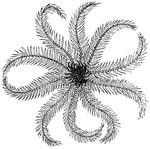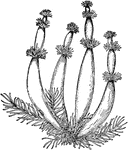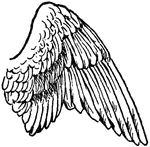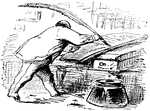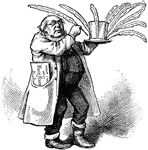
Respiration in Fishes
This figure shows the mode of respiration in fishes. The gills are seen bent over in the form of a feather.…
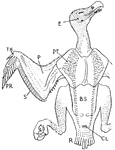
Lammergeier
"Young bearded griffin (Gypaetus barbatus). Showing the feather-tracts or pterylae, for instance those…
Feathers
"A., Filoplume. B., very young feather within its sheath (sh.); c., the core of dermis; b., the barbs.…
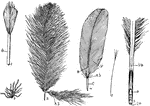
Feather Types
"Types of feathers. D., Down. 2, Developing feather in sheath (sh.). 3, Covert of heron showing aftershaft…
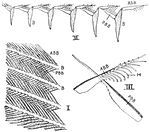
Feather Parts
"Parts of a feather. I., Four barbs (B.) bearing anterior barbules (A.BB.) and posterior barbules (P.BB.);…

Hoopoe
"Diagram showing the tracts where the principal growth of feathers occurs (Upupa epops). The dotted…

Pinnatifid
"Pinnate.--Term applied to a leaf when cut into many parallel segments, like the rose." -Newman, 1850
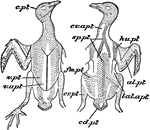
Rock Pigeon Feather Tracts
"Pterylosis of Columba livia. A, ventral; B, dorsal. al. pt, alar pteryla or wing-tract; c. pt, cephalic…
Cassowary Feather
"Casuarius (Cassowary). Feather, showing after-shaft and disconnected barbs." -Parker, 1900
Rough-Stemmed Golden-Rod
Of the Composite family (Compositae), the leaf of the rough-stemmed golden-rod (Solidago rugosa).

Feather Tube
"The feathers are horny productions, consisting of a hollow tube or barrel and a stem rising from it."
Feather Shaft
"The feathers are horny productions, consisting of a hollow tube or barrel and a stem rising from it."
Feather Web
"The feathers are horny productions, consisting of a hollow tube or barrel and a stem rising from it.…
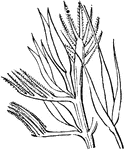
Feather Grass and Crested Dog's-Tail
"7. locusta of Stipa pennata" (Feather Grass); "8. rachis, bracteae, and florets of Cynosurus cristatus"…

Crawfish
Crayfish, crawfish, or crawdads are freshwater crustaceans resembling small lobsters, to which they…

Scroll Wheel
"a, scroll-wheel, intermeshing with the pinion b, which, sliding by a feather on the shaft, c, imparts…

Simple Crinoid
An illustration of a simple five armed crinoid with a detailed view of the tegmen of five orals. Crinoids,…

Crayfish
Crayfish, crawfish, or crawdads are freshwater crustaceans resembling small lobsters, to which they…
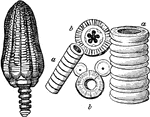
Encrinite
"Encrinite: head and piece of stem. Any fossil crinoid; a stone-lily: a term especially applied to the…

Encrinite
"Encrinite: Any fossil crinoid; a stone-lily: a term especially applied to the ordinary stalked form…

Crinoid
A modern crinoid showing steam with root or hold-fast attachment, and a crown composed of the calyx…

Feather and Tare
"Two pieces of metal placed in a hole in a stone which is to be split a wedge-shaped key or plug being…

Types of Files
"Files. a, cotter-file when large, and verge- or pivot-file when small; b, square file (parallel or…
Filoplume of a Goose
"Filoplume. In ornithology, a thread-feather; a thread-like or hair-like feather, with a very slender…
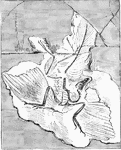
Archaeopteryx Lithographica
"Archaeornithes is at present represented by but one member, the first undoubted fossil Bird, made known…

Crayfish
Crayfish, crawfish, or crawdads are freshwater crustaceans resembling small lobsters, to which they…

Crayfish
Crayfish, crawfish, or crawdads are freshwater crustaceans resembling small lobsters, to which they…
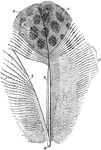
Feather from a Argus Pheasant
"Fig. 19 - A partly pennaceous, partly plumulaceous feather, from Argus pheasant; after Nitzsch. ad,…

Structure of a Feather
"Fig. - 20 - Two barbs, a, a, of a vane, bearing anterior, b, b, and posterior, c, barbules; enlarged;…
Single Barbule
"Fig. 21. -A single barbule, baring barbicels and hooklets; magnified; after Nitzsch. ...barbicels (another…

Barbs
"The arrangement shown in fig. 22, where a, a, a, a, are four barbs in transverse section, viewed from…
A Feather from the Tail of a Kingbird
"Fig. 23 - A feather from the tail of a kingbird, Tyrannus carolinensis, almost entirely pennaceous;…

Pterylosis of Cypselus Apus
"Fig. 24. - Pterylosis of Cyoselus apus, drawn by Coues after Nitzsch; right hand upper, left hand lower,…

Robin
"Robin: Upper parts slate-color, with a shade of olive. Head black, the eyelids and a spot before the…

Late 19th Century Winter Dress
This lady is wearing a late 19th century winter dress. She is also wearing a hat that includes a feather…

Flag of Swaziland, 2009
Color flag of Swaziland. Three horizontal bands of blue (top), red (triple width), and blue; the red…

Flag of Swaziland, 2009
Black and white outline flag of Swaziland. Three horizontal bands of blue (top), red (triple width),…

Blue-gray Gnat-catcher
"Grayish-blue, bluer on the crown, hoary on the rump, the forehead black, continuous with a black superciliary…

White-Breasted Nuthatch
"Upper parts, central tail-feathers, and much edging of the wings, clear ashy-blue; whole crown, nape,…

Geirrod and Loki
Geirrod the giant spies a bird on the chimney of his castle. It is really Loki wearing Freya's eagle…
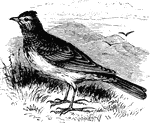
Skylark
"Sky-Lark. Upper parts grayish-brown, the feathers with darker centers; under parts whitish, tinged…

Painted Fly-catching Warbler
"Painted Fly-catching Warbler. Setophaga picta. Painted Redstart. Lustrous black; middle of breast and…
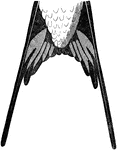
Barn Swallow Tail
"Hirundo horreorum. Barn Swallow. Tail deeply fornicate, nearly or about as long as the wings; lateral…

Butcher-bird
"Lanius borealis. Great Northern Shrike. Butcher-bird. Great Grey Shrike. Above, clear bluish-ash, blanching…



